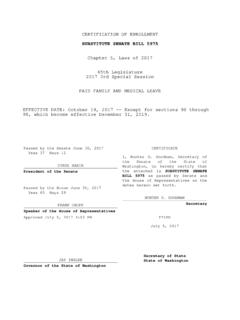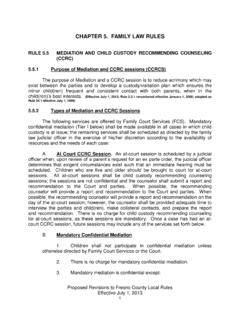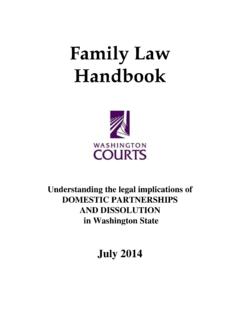Transcription of Chapter 5 MAKING AND MEETING OBJECTIONS - …
1 0001 VERSACOMP ( ) COMPOSE2 ( ) 07/31/02 (12:49). The Trial Process: Law, Tactics and Ethics J:\VRS\DAT\03106\ --- --- POST 1 1/1. Chapter 5. MAKING AND MEETING OBJECTIONS . INTRODUCTION. This Chapter is not a comprehensive review of the rules of evidence. We assume that you have already taken a course in evidence and remember the basic doctrines of relevancy, hearsay, privilege, competency, and opinion testimony. The rules of impeachment will be covered in the Cross- Examination Chapter . This Chapter concentrates instead on the procedure for invoking rules of evidence, as well other rules of trial conduct the objection . We will focus on how to make and respond to OBJECTIONS during the examination of witnesses, including: Proper objection procedure The tactics of OBJECTIONS How to respond to OBJECTIONS In addition, we will introduce you to some secondary procedures connected to OBJECTIONS you may not have covered in your Evidence class, such as: Motions to strike Offers of proof Admonitions to disregard inadmissible evidence Although we will focus on objecting to improper evidence while examining a witness, the same principles apply to OBJECTIONS to improper conduct during opening statement or closing argument.
2 Throughout this Chapter , we will focus on evidence as it is used in the course of a trial, not as it is argued on appeal. In the hectic atmosphere of the courtroom, precise in-depth legal analysis yields to advocacy, brevity, succinct- ness, and tactics. Your knowledge of evidence must be tempered with an understanding of discretion both yours and the judge's. You have discretion whether to object and how to object. Your decisions concerning when to object, when to forgo OBJECTIONS , and what to say when you object, all will flow from your theory of the case. The most important thing to remember is the broad scope of the judge's discretion in ruling on OBJECTIONS . The judge has several choices: Sustain. The judge sustains an objection if the judge thinks the objection is correct. If the judge sustains an objection , the evidence is not admissible. Overrule. The judge overrules an objection if the judge thinks the objection is not correct. The evidence is admissible.
3 Overrule subject to connecting up. If the judge thinks that an item of evidence will probably be admissible after more evidence 179. 0002 VERSACOMP ( ) COMPOSE2 ( ) 07/31/02 (12:49). The Trial Process: Law, Tactics and Ethics J:\VRS\DAT\03106\ --- --- POST 31 1/1. 180 MAKING AND MEETING OBJECTIONS CH. 5. is introduced, the judge may overrule the objection and admit the evidence now subject to the introduction of later evidence that will fill the gap 1 a process most lawyers call connecting up. If the proponent fails to connect it up, the judge may later reverse the ruling and exclude the evidence. Reserve ruling. If the judge thinks that an item of evidence will probably be admissible after more evidence is introduced, the judge may hold his or her ruling in abeyance to wait and see if the proponent can supply the missing foundation. If the item is an exhibit, the judge can set it aside, neither admitting nor excluding it, until the proponent has the opportunity to lay additional foundation.
4 You must learn to accept the fact that, except in extraordinary circum- stances, the trial judge's ruling is final, whether it is right or wrong. Few evidentiary errors warrant reversal on appeal. NOTE. What happens if the judge rules incorrectly? You may have the erroneous idea that the court of appeals can somehow correct errors made by the trial judge. It cannot. All the court of appeals can do is reverse the judgment and send the whole case back for a very expensive new trial. How likely is it that the appellate courts will order a new trial for erroneous evidence rulings? An empirical study by Prof. David Leonard suggests that the likelihood is small. He studied appeals concerning erroneous rulings under Federal Rules of Evidence 608 and 611, and found that only 5 percent were reversed. David P. Leonard, Appellate Review of Evidentiary Rulings, 70 L. REV. 1155, 1214 (1992). OBJECTIONS . If you go into any courtroom and watch a trial in progress, you probably will be struck by a disconcerting observation most trial lawyers seem to make and handle OBJECTIONS poorly.
5 Many lawyers make drawn out and poorly worded OBJECTIONS . Others just say, objection , without any explanation at all. Still others fail to make any OBJECTIONS . Knowing when and how to make and respond to OBJECTIONS is an integral part of being a successful trial lawyer. The materials in this section are designed to introduce you to the basic procedural, tactical, and ethical dimensions of the objection process. [A] objection PROCEDURE. The basic legal requirements for a proper objection are: Your objection must be timely it must be made as soon as the grounds become apparent. Your objection must be specific you must tell the judge exactly what you are objecting to, what rule of evidence or trial procedure has been violated, and exactly how it was violated. 1 See Fed. R. Evid. 104(b). 0003 VERSACOMP ( ) COMPOSE2 ( ) 07/31/02 (12:49). The Trial Process: Law, Tactics and Ethics J:\VRS\DAT\03106\ --- --- POST 47 2/2. OBJECTIONS 181. The timeliness requirement means you must object as soon as the grounds for objection become apparent.
6 This usually means that you will have to object to your opponent's questions, because it usually will be clear from the question that the answer will violate the rules of evidence. You cannot wait until after you hear the testimony. 2 For example, if a witness is asked What is your opinion of the plaintiff's character? you must object at once. You cannot wait, hoping for a favorable answer, and object only if the answer goes against you. However, if the question is innocuous ( What happened next? ), but the answer violates the rules of evidence ( I wasn't there, but Harry told me that the car skidded ), an objection is timely if made to the answer. 3 As a general rule, you also must not object too soon, although the judge has discretion to permit a premature objection . Even if you think you know what the question will be, and that it is going to elicit objectionable testimony, you must wait until your opponent has finished asking it. 4. The specificity requirement means that you must direct the judge's atten- tion to the evidence you object to, and the precise reason why the evidence is inadmissible.
7 You must state the exact ground for your objection , referring clearly to the rule being violated and explain how it is being violated. 5. Consider the following examples: Insufficient OBJECTIONS . I object.. I object. Why is this relevant? . objection , the evidence is very prejudicial.. objection . Counsel has not laid a proper foundation for the business record exception to the hearsay rule. 6. Proper OBJECTIONS . I object to the document on the ground that it violates the best evidence rule because it has not been shown to be the original.. I object to the use of the photograph under Rule 403. This picture of the corpse has little probative value because the fact of death has been stipulated, and it will unfairly arouse the emotions of the jury.. I object to the document as hearsay. Counsel has not laid a proper foundation for a business record because she has not shown that the entrant had personal knowledge of the transaction.. Complying with these requirements will not necessarily preserve the issue for appeal.
8 You must renew the objection if your opponent offers the same 2 See, , Crowne Invest. v. Reid, 740 So. 2d 400, 408 (Ala. 1999). 3 See, , Roberts v. Newille, 554 298, 300 (Iowa App. 1996). 4. See, Hanson v. State, 55 681, 696 (Tex. App. 2001). 5. See, , Gen. Motors Corp. v. Harper, 61 118, 125-26 (Tex. App. 2001). 6 This objection is inadequate because there are six different foundation requirements for a business record, and the objection does not tell the judge which one is missing. 0004 VERSACOMP ( ) COMPOSE2 ( ) 07/31/02 (12:49). The Trial Process: Law, Tactics and Ethics J:\VRS\DAT\03106\ --- --- POST 61 7/7. 182 MAKING AND MEETING OBJECTIONS CH. 5. evidence a second time. You also must object to all similar evidence or you will waive the right to appeal the original erroneous ruling (it becomes harmless error). 7 To partially alleviate this burden, some jurisdictions allow a continuing objection to be made that preserves the error without requiring you to enter many useless OBJECTIONS to similar testimony when you know the judge will just overrule them.
9 8. What if a judge has made a pretrial ruling on the admissibility of evidence? You still must enter an objection if the evidence is offered during trial. If the judge has excluded evidence, but your opponent tries to offer it anyway, you must renew your objection . Otherwise, the jurors will hear the evidence and you will have waived your right to appeal on the issue. If the judge's pretrial ruling erroneously allowed inadmissible evidence to be used, you must object again when the evidence is offered at trial to preserve the issue for appeal. 9. [B] HOW TO MAKE AN objection . Stand up 10. Tell the judge that you object Describe what evidence you object to State the exact grounds Cite the legal rule Give a one-sentence explanation Allow your opponent to speak without interruption Remain standing until the judge rules on the objection Accept the judge's ruling gracefully and sit down 11. Standing up when you address the judge is a formality required in all courts.
10 It will attract the judge's attention, which you obviously need to do in order to object. It will also tend to disrupt the proceedings, drawing the witness's and opposing attorney's attention to yourself, and stopping the testimony. This minimizes the damage that might be caused if the witness continued talking about inadmissible evidence. Attracting the jurors' attention away from the witness further minimizes the harm if the witness continues to talk about inadmissible evidence. Arguing from a standing position conveys a more positive attitude than sitting down. Stating specific grounds is more than just complying with a rule of appellate procedure. No trial judge can be expected to recall all the intricacies of the rules of evidence in an instant. If you direct the judge's attention to the precise rule, you increase the likelihood of a favorable ruling. At least the judge will 7 See, , Hoover v. Burlington , 559 729, 733 (Neb. 1997); State v. Wingo, 403.
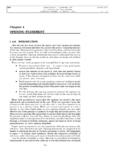
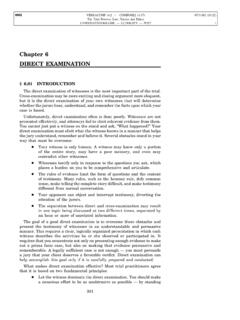
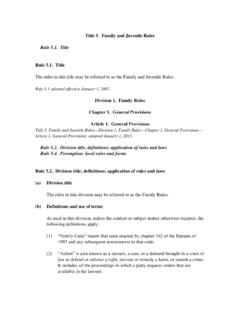
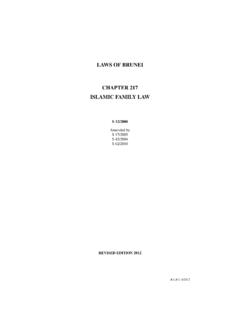
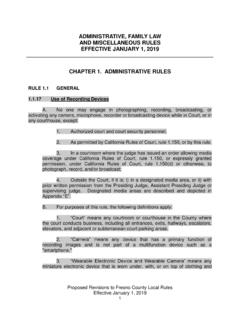
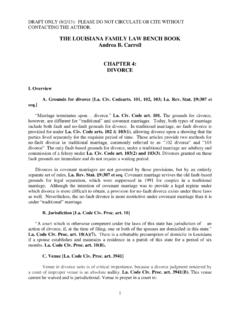
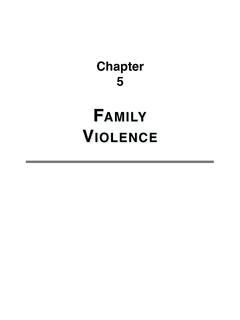
![CHAPTER 5 - [OFFENSES] - indianlaw.mt.gov](/cache/preview/a/f/b/0/c/0/0/b/thumb-afb0c00bde8407c6a9ae0a4fc2364016.jpg)
